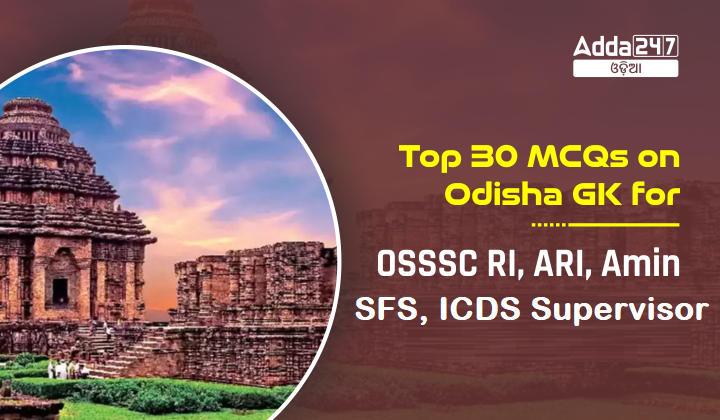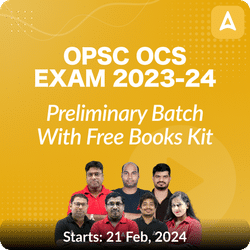General Knowledge is a crucial component of competitive exams, and when it comes to Odisha, a rich tapestry of history, culture, and geography awaits exploration. As you prepare for OSSSC RI, ARI, Amin, SFS, ICDS Supervisor exams, mastering Odisha GK is indispensable. This article presents a curated set of Top 30 Odisha General Knowledge Multiple-Choice Questions (MCQs) to sharpen your knowledge base and boost your exam readiness.
Top 30 Odisha GK MCQS For OSSSC RI,ARI, Amin, SFS, ICDS Supervisor
- What is the purpose of establishing the Biju Patnaik Aviation Centre (BPAC) at the Birasal airstrip in Dhenkanal district?
A) To create a commercial airport for international flights
B) To establish a tourism hub in the district
C) To provide aviation training and pilot education
D) To host annual air shows and exhibitions
Answer: C) To provide aviation training and pilot education
- In which district of Odisha is the Biju Patnaik Aviation Centre (BPAC) planned to be established?
A) Bhubaneswar
B) Cuttack
C) Puri
D) Dhenkanal
Answer: D) Dhenkanal
- Which institute collaborated with Odisha State Disaster Management Authority (OSDMA) to strengthen disaster preparedness?
A) Indian Institute of Technology, Delhi
B) National Institute of Technology, Rourkela
C) Regional Integrated Multi-Hazard Early Warning System (RIMES), Bangkok
D) University of Hyderabad
Answer: C) Regional Integrated Multi-Hazard Early Warning System (RIMES), Bangkok
- What is the purpose of the collaboration between OSDMA, RIMES, and Amrita Vishwa Vidyapeetham?
A) To establish research facilities in natural sciences
B) To strengthen disaster preparedness through impact-based forecasting and early warning dissemination
C) To create a platform for international trade
D) To launch new educational programs in the state
Answer: B) To strengthen disaster preparedness through impact-based forecasting and early warning dissemination
- Odisha State Disaster Management Authority (OSDMA) falls under which ministry?
A) Ministry of Health and Family Welfare
B) Ministry of Rural Development
C) Ministry of Environment, Forest and Climate Change
D) Ministry of Home Affairs
Answer: D) Ministry of Home Affairs
- What is the full form of OSDMA?
A) Odisha State Development Management Association
B) Odisha State Disaster Management Authority
C) Odisha State Disease Monitoring Association
D) Odisha State Domestic Market Association
Answer: B) Odisha State Disaster Management Authority
- In which Indian state was the ‘Ama Bank’ initiative launched to extend banking services to all unbanked panchayats?
A) Karnataka
B) Odisha
C) Maharashtra
D) Tamil Nadu
Answer: B) Odisha
- What is the primary objective of the ‘Ama Bank’ initiative launched in Odisha?
A) To promote foreign investments in the state
B) To encourage the use of digital payments in urban areas
C) To provide banking services to all unbanked panchayats in Odisha
D) To establish new bank branches in every city
Answer: C) To provide banking services to all unbanked panchayats in Odisha
- How many CSP Plus outlets (Customer Service Points) were launched under the ‘Ama Bank’ initiative in Odisha?
A) 1,500
B) 1,800
C) 2,000
D) 2,500
Answer: C) 2,000
- Kuldiha Wildlife Sanctuary is located in which Indian state?
A) West Bengal
B) Jharkhand
C) Odisha
D) Chhattisgarh
Answer: C) Odisha
- Kuldiha Wildlife Sanctuary is situated in which district of Odisha?
A) Cuttack
B) Puri
C) Balasore
D) Bhadrak
Answer: C) Balasore
- Which type of forest is predominantly found in Kuldiha Wildlife Sanctuary?
A) Evergreen forest
B) Mixed deciduous forest dominated by Sal trees
C) Coniferous forest
D) Mangrove forest
Answer: B) Mixed deciduous forest dominated by Sal trees
- The sustainability grants extended to 11 research centers of excellence (CoEs) in Odisha are part of which program?
A) Odisha Higher Education Initiative for Equity and Excellence (OHEIEE)
B) Odisha Higher Education Programme for Excellence and Equity (OHEPEE)
C) Odisha Advanced Education Programme (OAEP)
D) Odisha Education and Research Support Initiative (OERSI)
Answer: B) Odisha Higher Education Programme for Excellence and Equity (OHEPEE)
- How much total sustainability grant was awarded to the 11 CoEs for the academic sessions of 2023-24 and 2024-25 under the Mukhyamantri Research and Innovation Fellowship programme?
A) Rs 45 lakh
B) Rs 50 lakh
C) Rs 61.5 lakh
D) Rs 75 lakh
Answer: C) Rs 61.5 lakh
- Which research center at Sambalpur University received the highest grant, and how much was the grant?
A) Research on ‘biotechnology and bioinformatics’ received Rs 25 lakh
B) Research on ‘agricultural sciences’ received Rs 30 lakh
C) Research on ‘natural products and therapeutics’ received Rs 35 lakh
D) Research on ‘environmental sciences’ received Rs 40 lakh
Answer: C) Research on ‘natural products and therapeutics’ received Rs 35 lakh
- Which phase of the Rashtriya Uchchatar Shiksha Abhiyan (RUSA) is mentioned in the context of the CoEs in Odisha?
A) Phase One
B) Phase Two
C) Phase Three
D) Phase Four
Answer: B) Phase Two
- What types of support are being provided to the CoEs under the Mukhyamantri Research and Innovation Fellowship programme?
A) Research grants to fellows and maintenance of equipment
B) Research internships, publication of critical texts
C) Engagement of research associates
D) All of the above
Answer: D) All of the above
- Until what year has the Odisha government extended its command area development and water management scheme?
A) 2025
B) 2027
C) 2029
D) 2031
Answer: C) 2029
- What is the total outlay of the Odisha government’s command area development and water management scheme?
A) Rs 500 crore
B) Rs 763.47 crore
C) Rs 1,000 crore
D) Rs 900 crore
Answer: B) Rs 763.47 crore
- How many kilometers of field channel network are planned for construction in the 80,000 hectares of command area?
A) 1,200 km
B) 3,600 km
C) 2,400 km
D) 3,000 km
Answer: C) 2,400 km
MCQ 4: What is one of the main goals of the scheme related to water management?
A) To promote tourism in the state
B) To enhance production and productivity through on-farm water management and crop diversification
C) To establish new urban areas in the state
D) To promote industrialization
Answer: B) To enhance production and productivity through on-farm water management and crop diversification
- How much funding does the Mahatma Gandhi National Rural Employment Guarantee Act (MGNREGA) contribute to the scheme?
A) Approximately Rs 108 crore
B) Approximately Rs 200 crore
C) Approximately Rs 150 crore
D) Approximately Rs 50 crore
Answer: A) Approximately Rs 108 crore
- NTPC’s Kaniha power plant is located in which district of Odisha?
A) Khordha
B) Angul
C) Balasore
D) Puri
Answer: B) Angul
- What is the installed capacity of NTPC’s Kaniha power plant?
A) 1500MW
B) 3000MW
C) 4500MW
D) 5000MW
Answer: B) 3000MW
- The source of water for NTPC’s Kaniha power plant is from which reservoir?
A) Hirakud Reservoir
B) Chilika Lake
C) Samal Barrage Reservoir
D) Puri Lake
Answer: C) Samal Barrage Reservoir
- The fire at NTPC’s Kaniha power plant originated from which part of the plant?
A) Cooling tower
B) Turbine generator
C) Coal transporting conveyor belt
D) Control room
Answer: C) Coal transporting conveyor belt
- Which of the following states does the Talcher power plant supply power to?
A) Odisha, Andhra Pradesh, Karnataka, Telangana, Bihar, and West Bengal
B) Odisha, Tamil Nadu, Kerala, Gujarat, and Maharashtra
C) Odisha, Punjab, Haryana, Rajasthan, and Uttar Pradesh
D) Odisha, Sikkim, Assam, Manipur, and Meghalaya
Answer: A) Odisha, Andhra Pradesh, Karnataka, Telangana, Bihar, and West Bengal
- Which rivers in southern Odisha are currently facing a lack of water according to data from the Central Water Commission?
A) Baitarani, Subarnarekha, Brahmani, and Budhabalanga
B) Rushikulya, Bahuda, Vamsadhara, and Nagavali
C) Mahanadi, Brahmani, Baitarani, and Subarnarekha
D) Ganga, Yamuna, Godavari, and Krishna
Answer: B) Rushikulya, Bahuda, Vamsadhara, and Nagavali
- What is one of the main causes attributed to the lack of water in the rivers of southern Odisha?
A) Excessive rainfall
B) Strong wind patterns
C) Reduced monsoon rainfall and changes in rainfall patterns
D) Rising sea levels
Answer: C) Reduced monsoon rainfall and changes in rainfall patterns
- What did Nitin Bassi from the Council on Energy, Environment and Water (CEEW) suggest to reduce the water deficit in the Mahanadi river basin?
A) Building more dams and reservoirs
B) Implementing water diversion projects
C) Adopting micro-irrigation systems and changing cropping patterns
D) Increasing the use of groundwater
Answer: C) Adopting micro-irrigation systems and changing cropping patterns
- Which town in Odisha has a very poor Air Quality Index (AQI) value of 304, as reported by the Central Pollution Control Board (CPCB)?
A) Bhubaneswar
B) Barbil
C) Cuttack
D) Rourkela
Answer: B) Barbil
- What were the AQI values recorded in Keonjhar and Nayagarh in Odisha on the same day when Barbil had a very poor AQI?
A) 100 and 150 respectively
B) 200 and 250 respectively
C) 228 and 275 respectively
D) 300 and 350 respectively
Answer: C) 228 and 275 respectively





